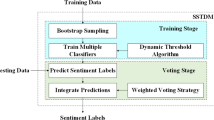Abstract
In sentiment classification, labeled data is often limited while unlabeled data is ample. This motivates semi-supervised learning for sentiment classification to improve the performance by exploring the knowledge in unlabeled data. In this paper, we analyze the possibility and the difficulty of semi-supervised sentiment classification and indicate that noisy features may be the main reason for badly influencing the performance. To overcome this problem, we propose a novel self-training approach where multiple feature subspace-based classifiers are utilized to explore a set of good features for better classification decision and to select the informative samples for automatically labeling. Evaluation over multiple data sets shows the effectiveness of our self-training approach for semi-supervised sentiment classification.
Access this chapter
Tax calculation will be finalised at checkout
Purchases are for personal use only
Preview
Unable to display preview. Download preview PDF.
Similar content being viewed by others
References
Abney, S.: Bootstrapping. In: Proceedings of ACL 2002, pp. 360–367 (2002)
Blitzer, J., Dredze, M., Pereira, F.: Biographies, Bollywood, Boom-boxes and Blenders: Domain Adaptation for Sentiment Classification. In: Proceedings of ACL 2007, pp. 440–447 (2007)
Craven, M., DiPasquo, D., Freitag, D., McCallum, A., Mitchell, T., Nigam, K., Slattery, S.: Learning to Extract Symbolic Knowledge from the World Wide Web. In: Proceedings of AAAI 1998, pp. 509–516 (1998)
Cui, H., Mittal, V., Datar, M.: Comparative Experiments on Sentiment Classification for Online Product Reviews. In: Proceedings of AAAI 2006, pp. 1265–1270 (2006)
Dasgupta, S. Ng, V.: Mine the Easy, Classify the Hard: A Semi-Supervised Approach to Automatic Sentiment Classification. In: Proceedings of ACL-IJCNLP 2009, pp. 701–709 (2009)
Joachims, T.: Transductive Inference for Text Classification Using Support Vector Machines. In: Proceedings of ICML 1999, 200–209 (1999)
Kullback, S., Leibler, R.: On Information and Sufficiency. Annals of Mathematical Statistics 22(1), 79–86 (1951)
Li, S., Huang, C., Zhou, G., Lee, S.: Employing Personal/Impersonal Views in Supervised and Semi-supervised Sentiment Classification. In: Proceedings of ACL 2010, pp. 414–423 (2010)
Li, S., Wang, Z., Zhou, G., Lee, S.: Semi-supervised Learning for Imbalanced Sentiment Classification. In: Proceeding of IJCAI 2011, 1826–1831 (2011c)
Liu, B.: Sentiment Analysis and Opinion Mining (Introduction and Survey). Morgan & Claypool Publishers (May 2012)
Pang, B., Lee, L., Vaithyanathan, S.: Thumbs up? Sentiment Classification using Machine Learning Techniques. In: Proceedings of EMNLP 2002, pp. 79–86 (2002)
Pang, B., Lee, L.: Opinion Mining and Sentiment Analysis: Foundations and Trends. Information Retrieval 2(12), 1–135 (2008)
Riloff, E., Patwardhan, S., Wiebe, J.: Feature Subsumption for Opinion Analysis. In: Proceedings of EMNLP 2006, pp. 440–448 (2006)
Turney, P.: Thumbs up or Thumbs down? Semantic Orientation Applied to Unsupervised Classification of reviews. In: Proceedings of ACL 2002, 417–424 (2002)
Wilson, T., Wiebe, J., Hoffmann, P.: Recognizing Contextual Polarity: An Exploration of Features for Phrase-Level Sentiment Analysis. Computational Linguistics 35(3), 399–433 (2009)
Yarowsky, D.: Unsupervised Word Sense Disambiguation Rivaling Supervised Methods. In: Proceedings of ACL 2005, pp. 189–196 (1995)
Zhou, S., Chen, Q., Wang, X.: Active Deep Networks for Semi-Supervised Sentiment Classification. In: Proceeding of COLING 2010, Poster, pp. 1515–1523 (2010)
Author information
Authors and Affiliations
Corresponding author
Editor information
Editors and Affiliations
Rights and permissions
Copyright information
© 2014 Springer International Publishing Switzerland
About this paper
Cite this paper
Gao, W., Li, S., Xue, Y., Wang, M., Zhou, G. (2014). Semi-supervised Sentiment Classification with Self-training on Feature Subspaces. In: Su, X., He, T. (eds) Chinese Lexical Semantics. CLSW 2014. Lecture Notes in Computer Science(), vol 8922. Springer, Cham. https://doi.org/10.1007/978-3-319-14331-6_23
Download citation
DOI: https://doi.org/10.1007/978-3-319-14331-6_23
Published:
Publisher Name: Springer, Cham
Print ISBN: 978-3-319-14330-9
Online ISBN: 978-3-319-14331-6
eBook Packages: Computer ScienceComputer Science (R0)




